Apple has been granted a patent (number 11,221,488) for “tunable and foveated lens systems.” It involves the sort of “Apple Glasses” — augmented reality/virtual reality glasses — I could really get behind.
About the patent
The patent likely involves the second generation of Apple Glasses that likely won’t debut until 2024. Unlike the first iteration — which will likely be a head-mounted display (HMD) — it should be weigh less, have longer battery life, and look more like traditional eyeglasses.
In the patent filing, Apple notes that eyewear may include optical systems such as lenses. For example, eyewear such as a pair of glasses may include lenses that allow users to view the surrounding environment.
Apple says that, however, it can be challenging to design devices such as these. If care isn’t taken, the optical systems in these devices may not be able to accommodate different eye prescriptions and may not perform satisfactorily. Apple wants its Apple Glasses to be user-friendly to everyone, whatever their vision.
Summary of the patent
Here’s Apple’s abstract of the patent: “A pair of eyeglasses may include one or more adjustable lenses that are each configured to align with a respective one of a user’s eyes. The adjustable lenses may include a foveated liquid crystal adjustable lens stacked with a non-liquid-crystal adjustable lens such as a fluid-filled lens or an Alvarez lens. The foveated adjustable lens may include electrically modulated optical material such as one or more liquid crystal cells.
“The liquid crystal cells may include arrays of electrodes that extend along one, two, three, four, or more than four directions. Control circuitry may apply control signals to the array of electrodes in each liquid crystal cell to produce a desired phase profile. Each lens may be foveated such that portions of the lens within the user’s gaze exhibit a different phase profile than portions of the lens outside of the user’s gaze.”
Article provided with permission from AppleWorld.Today

